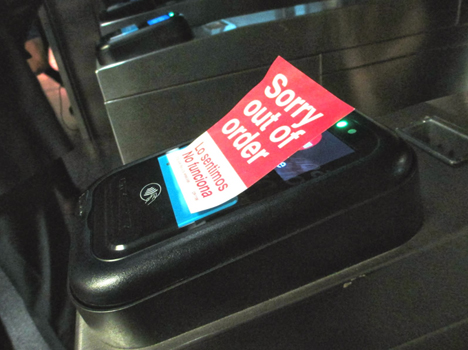Victor Margolin

In recent weeks, I have been involved in three chaotic attempts to introduce changes in services that I have come to rely on. These include banking, public transit, and healthcare. The website of Obamacare is not the only evidence of innovative change that is malfunctioning. I would venture to say that a good many if not most of the new services that are being rolled out at a dizzying pace have glitches that range from minor to catastrophic.
The three in which I have recently been involved are now close to being resolved but resolution has not come without considerable headaches, anxiety, and hours wasted in futilely attempting to overcome frustrations. The first of the three situations that I had to deal with was the absorption of my bank into a larger banking network. Ever since my wife and I became enmeshed in the confused reorganization of a large national bank some years ago, we have tried to patronize local banks, which today are few and far between. When we moved to downtown Chicago we looked for a local bank and found one with only three branches. The manager of the branch where we opened our account was an extremely friendly soul and helped us immensely on frequent occasions.
During his tenure at the bank, there was one merger that mercifully did not affect our accounts, but a second and larger merger occurred just as he retired. We were supposed to have received some literature about this merger, informing us that one of our accounts was to be renumbered but we somehow missed it and consequently one account was renumbered without us knowing it. When we went to the bank to straighten this out, the teller renumbered the account yet again, virtually insuring that none of the funds that were transferred into the account on a monthly basis would ever get there. We were promised checks for this new account just as we were promised checks for the first changed account but neither package of checks ever arrived. Once our account number had been changed for a second time, we immediately abandoned the bank and opened a checking account at a different bank where we already had another account. We subsequently closed all accounts at the newly merged bank and opened them elsewhere. Fortunately, we were able to straighten out all the regular funds transfers to new accounts and are now successfully regrouped.
As an informal student of service design, I tried to analyze the situation and understand why things might have gone awry. What I believe was lacking in this situation as in the others that I have had to deal with recently is an absence of design. For more than fifty years, farsighted design theorists have been calling for design strategies that could be applied to organizations to help them think productively about the increasingly complex problems they face. The rapid rate of mergers, takeovers, and corporate reinventions has frequently caused havoc for customers and clients who were not adequately informed of changes or assisted with new procedures. The transition from one organizational structure or policy to another is indeed a design problem that requires professional guidance. It took many companies years to understand that they could not simply hand off the design of a new product to an employee who had a flair for drawing but instead they required the services of a trained industrial designer to insure that their new product benefited from professional expertise. The amateurs could produce something but rarely a product that was noteworthy. Well, that battle has been won in industry and today it is the rare company that does not believe in the expertise of trained product designers to deliver a quality design.
Unfortunately this is not yet the case when it comes to designing processes for organizational change. In the first place, there are few designers who are trained to introduce design expertise to management and, second, few managers believe that the complex situations in which they are involved are design problems. There is a parallel in the early 1950s before Simon Ramo and a few other farsighted engineers introduced systems analysis to the process of designing and manufacturing complex weapons. It worked so well for the U.S. Air Force – the first organization to adopt such systems – that a group of Air Force experts were seconded to NASA when the space program began to design comparable systems for the production of the Mercury, Apollo, and Gemini spacecraft.
In the case of designing and manufacturing hardware, the framework of engineering knowledge within which such designs are produced allows for a relatively easy detection of design flaws. Either the equipment works when it is tested or it doesn’t and if it doesn’t then there are ways to discover that. The same is not the case for the design of complex systems that involve human beings. In such cases decisions are frequently made whose faulty premises only become evident when they adversely affect the human users for whom they are intended. The results are frustration and anger as well as the inability to deliver the necessary documents or devices that users require to participate in the new system.

Such is the case with the roll out of a new fare payment system for the Chicago Transit Authority, which is changing over from one system of adding money electronically to a fare card to another. The first system worked perfectly well, although fare card holders could not move with the same card between different systems such as the railroad and the subway that form part of a larger integrated transport network. As with many activities today, the transition to a new fare payment system was outsourced to a private company by the CTA. In addition to introducing a new fare card, the company, which adopted the name Ventra for the new system, also wanted to add a credit card to the system, thereby enticing public transit riders to use their fare cards as credit cards as well. This bundling of functions combined with the lack of organization in rolling out the new system has resulted in large-scale chaos that is still far from being alleviated. The problems of Cubic Transportation Systems, the private company that won the bid for the fare card contract, are myriad. They range from being late to send new fare cards to senior citizens who had reduced fare permits, to not having enough people to activate the cards, to providing misinformation to people who called in, deducting money from the cards in ways that were unanticipated and many other problems. It is as if they had not foreseen any of the situations that should have been addressed during the planning period. On suspects that the company was reluctant to hire and train sufficient staff to manage the roll out and consequently they have yet to receive any payment at all from the City of Chicago and won’t be paid until the system is up and working properly. If one transposed such a lack of planning to the design of a complex product such as a car, for example, you would imagine the car not starting, parts falling off, and the vehicle becoming useless before anyone ever drove it. If the auto industry operated without the high level of technical planning required to insure that a new car performs as promised, the entire industry would crash in a matter of days.
Unfortunately, the difference between designing a car and a fare card system is that there is competition among automobile manufacturers and a consumer can always opt to purchase a better car than one that does not perform as it should, while on the other hand citizens are held captive to city services on which they depend and which they are obliged to use. A city has only one metropolitan transit system and if it is not working as it should, there is no possibility to choose another. Consequently, thousands of Chicago citizens are irate because the debut of the new fare cards has been such a failure due to an absence of adequate planning and the inability to foresee the multitude of glitches that have hampered the new system’s successful introduction.

The third situation in which I have been involved recently is the process of choosing a new health care provider. My wife and I are both retirees from universities in the State of Illinois. Besides Medicare, I have supplemental insurance that has until the present been paid for by the State of Illinois. Now the State has decided to change the way it supports the health care of retirees by introducing several new systems that are known as Medicare Advantage. Without going into details, all retirees from one of the three state retirement systems received an announcement not long ago that they had to either switch to one of the new programs that the state was providing or else opt out entirely and purchase supplemental insurance directly from Medicare. A series of meetings has been held throughout the state. While there have been some threads of clarity, there has also been considerable confusion regarding the precise nature of the different plans and what benefits consumers might be expected to receive. For my wife and I, it required a considerable amount of networking, making phone calls, and trying to choose between conflicting sources of information. While this roll out has worked better than some, the delay in getting information from the various Medicare Advantage providers was a problem, as has been the clogged phone lines of the Central Management Service, which is overseeing the transition for the state. It should not be much of a surprise, however, that the companies that are hoping to attract new customers have been better at providing adequate call centers, although in the case of one provider with whom I spoke, the levels of knowledge about the program varied considerably from one sales assistant to another.
What has been missing in the three programs that I have described is a set of testing standards to determine whether or not the introduction of the new service is going well or not. Unfortunately, the problems don’t usually become evident until the users or consumers of the service are confronted with an inadequacy or failure. By that time, confusion and frustration have set in and, consequently, become new components of the process that have to be addressed. In a time of rapid change, large system transitions are becoming the norm rather than the exception. Because of that, there is an urgent need to recognize such transitions as design problems and both prepare designers to manage them with expertise and persuade system managers that they need the designer’s knowledge in order to insure the success of their projects and avert the inevitable backlashes that come from making mistakes. Since complexity in human systems as well as in products is now the order of the day, we must address it and design to accommodate it in order to stave off the chaos that is the inevitable consequence of ambitious but poorly prepared new service roll outs. In the case of public services, it is politicians who will shoulder much of the blame for faulty service delivery, as was the case with the Obamacare website the President wrongly assumed would contribute to the success of a policy on which he has staked the legacy of his presidency.
Victor Margolin is Professor Emeritus of Design History at the University of Illinois, Chicago. He is currently working on a World History of Design to be published by Berg in London.











Leave a Reply
You must be logged in to post a comment.